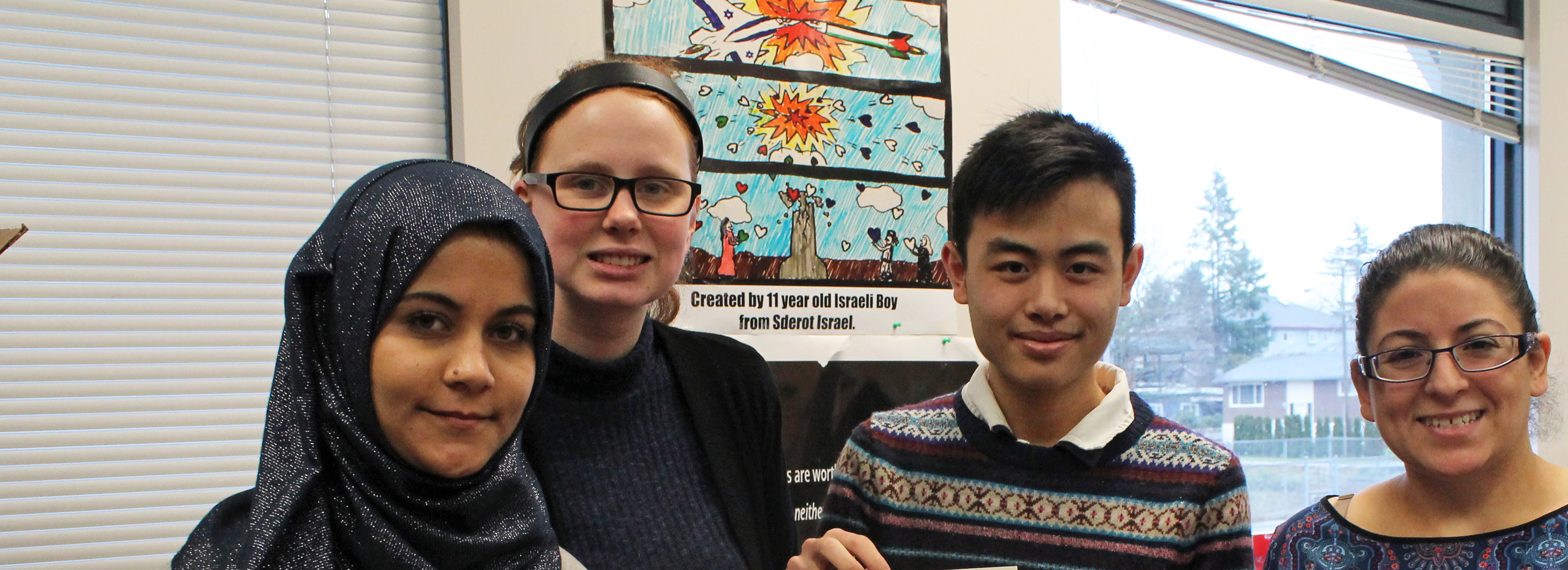How one secondary school in Surrey is welcoming Syrian refugees
Canadians have demonstrated humanitarian spirit and openness in responding to the Syrian refugee crisis, which the United Nations Refugee Agency (UNHCR) has called the world’s single largest refugee crisis. Since the conflict started over four years ago, more than 11 million Syrians have been forced out of their country. The Government of Canada, under Prime Minister Justin Trudeau, has responded by proposing to resettle 25,000 Syrian refugees in Canada.
BCCIE visited students at L.A. Matheson, a public secondary school in Surrey, to hear their heartwarming story as they put together hundreds of welcome boxes for incoming Syrians.
What we saw when we arrived was a classroom (fittingly the Social Justice classroom) converted into an assembly line of stuffed animals, toys, classroom supplies, books, and copies of the Canadian Charter of Rights and Freedoms – all items to be included in the welcome boxes.
Teacher Annie Ohana is leading the initiative, and to date over 300 boxes have been created. Some students even met at Metrotown on New Year’s Day to solicit donations from stores.
Ohana teaches languages and Social Justice at L.A. Matheson. She also leads the Global Issues Club, an extracurricular club for students with an interest in International Affairs.
At a school where close to half the 1300 students have origins outside of Canada, L.A. Matheson is intrinsically globally-focused, making it an ideal landing place for BC’s several hundred anticipated school-aged refugees.
Rows of international flags adorn the halls at L.A. Matheson, representing the origins of its students. L.A. Matheson acknowledges several cultural holidays and teaches a variety of languages, including Punjabi, French, and Spanish. It is not an international school by definition, but it looks and feels like one.
“It is about paying it forward” says grade 12 student
Caitlin Heidi, a grade 12 student who is President of the Global Issues Club, says that she has been interested in world affairs from a young age. “It is about paying it forward,” she says of the welcome boxes. “Small gestures of kindness go a long way.”
Some of the participating students from Ohana’s social justice class were migrants themselves. Safia Sharif’s family moved to Canada from Afghanistan two years ago, and when she arrived she spoke little English. Now she is fluent. Leo Huang emigrated from China and now speaks English as if it were his native language.
Marik Sandhu, who teaches English Language Learners (ELL) classes, says that although the school does not know the exact number of Syrian students they will be receiving, they remain flexible and will draw on past experience working with migrant youth. His classroom is filled with students from countries such as India, the Philippines, Somalia, and Afghanistan. “They can practice their English without being self-conscious here. Students are able to learn from their mistakes in a non-judgmental atmosphere where we laugh together and learn together." His students attend specialized English classes but are integrated with the entire student body, a best practice for schools that want to encourage unity.
Punjabi teacher Gurpreet Bains says that the school will have to be quick to adapt to newcomers. Some of these students have suffered immensely and witnessed trauma and loss. When they come to school, it is not just about academic learning – but about adjusting to Canadian culture. “Simple things like a ringing bell at the end of the class may be startling. We have to explain to kids how a classroom works.” Schools like L.A. Matheson hope to teach social and cultural norms in addition to regular academic subjects. “We are trying to teach compassion and kindness here,” Gurpreet affirms. “GPAs are important but being a good person is more important.”'
This spirit of compassion has had a ripple effect throughout the school, and many are leading efforts to welcome Syrians.
Art teacher Swetha Ranasuriya, who is from Sri Lanka herself, watches as students paint artwork for the welcome boxes. “It is nice to include something handmade. It adds a personal touch."
As Ohana says “No one has told our students ‘you have to do this.’ They just want to help in any way they can.”
Education as an essential human need
When we think of basic needs, we may think of shelter, food, security, and health care. Education might not immediately come to mind, but is essential for developing students’ skills and confidence. Many Syrian refugees have had their entire lifetime of studies disrupted due to conflict; only a small percentage have been able to continue on to higher education, leading to what has been called a “lost generation.”
Without education, refugees will be unable to help rebuild their country. Education can secure employment and financial security, and as we have seen at L.A. Matheson, it can also help acclimatize students to Canadian life – and importantly, make new friends.
In an environment where migrants are integrated and seen as part of the fabric of the school, the chance that they will thrive and be able to share their cultural backgrounds and histories with domestic students increases.



